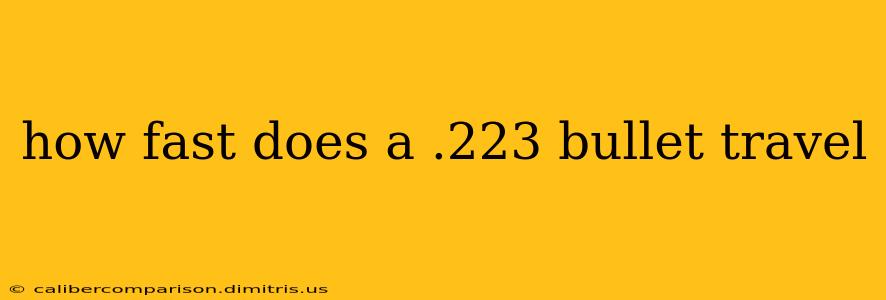The speed of a .223 bullet isn't a single, fixed number. Several factors influence its velocity, making it crucial to understand the variables at play. This article will delve into the specifics, providing a comprehensive understanding of .223 bullet speeds and the elements that affect them.
Factors Affecting .223 Bullet Velocity
Several key factors determine the muzzle velocity (speed as it leaves the barrel) and the downrange velocity (speed at various distances) of a .223 bullet:
1. Barrel Length: A Major Influence
The length of the rifle barrel significantly impacts velocity. Longer barrels allow more time for the expanding propellant gases to push the bullet, resulting in higher muzzle velocity. A shorter barrel equates to less time for acceleration and, therefore, a lower muzzle velocity. You'll generally see a noticeable difference between a 16-inch barrel and a 20-inch or longer barrel.
2. Powder Charge: The Propellant's Power
The amount of gunpowder used in a cartridge directly affects the bullet's velocity. A heavier powder charge generates more gas pressure, propelling the bullet faster. Manufacturers often offer different ammunition loads with varying powder charges, leading to different velocities for the same bullet weight.
3. Bullet Weight: The Mass Matters
Heavier bullets require more force to accelerate to the same speed as lighter bullets. Therefore, lighter bullets generally travel faster than heavier bullets fired from the same cartridge with the same powder charge. This is a crucial aspect to consider when selecting ammunition for specific applications.
4. Barrel Twist Rate: Stabilizing the Flight
The rate of twist in the rifle's barrel affects bullet stability. While not directly impacting initial velocity, a properly matched twist rate ensures the bullet remains stable in flight, maintaining accuracy and consistent velocity over distance. An improperly matched twist rate can lead to decreased accuracy and potentially lower downrange velocity due to instability.
5. Environmental Conditions: Wind and Temperature
Environmental factors play a role. Headwinds will slow down a bullet, while tailwinds will increase its effective velocity. Temperature also affects the propellant's burn rate and, consequently, the bullet's velocity. Cooler temperatures generally lead to slightly higher velocities than warmer temperatures.
Typical .223 Bullet Velocities
While precise figures depend on the factors listed above, a common range for .223 Remington/5.56 NATO ammunition fired from a standard 20-inch barrel is 2,800 to 3,200 feet per second (fps). This translates to approximately 850 to 975 meters per second (m/s). However, shorter barrels will yield lower velocities, potentially in the 2,500 to 2,900 fps range.
Understanding Downrange Velocity
It's crucial to remember that the muzzle velocity is not maintained throughout the bullet's flight. Air resistance (drag) slows the bullet down considerably as it travels. The bullet's velocity decreases progressively with distance, ultimately dropping to a much lower speed before impacting the target. This decrease is more significant at longer ranges.
Conclusion
The speed of a .223 bullet is a complex issue influenced by multiple variables. While a general range can be provided, precise velocity depends on the specific ammunition, rifle, and environmental conditions. Understanding these factors is essential for anyone using .223 ammunition, whether for hunting, sport shooting, or self-defense. Always consult the ammunition manufacturer's data for precise velocity specifications for your specific load.

